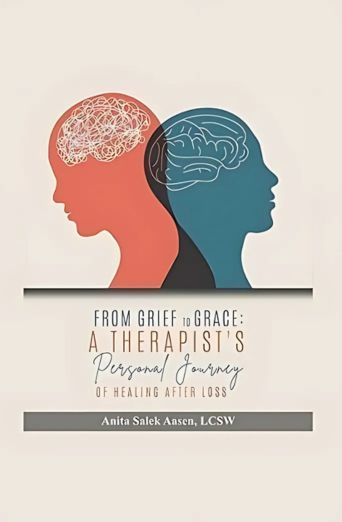By: Elowen Gray
When grief strikes, it doesn’t politely knock. It barges in uninvited and unrelenting, demanding attention and reshaping life in an instant.
For Anita Aasen, a licensed clinical social worker and therapist, grief wasn’t just a clinical concept—it became personal. Her book From Grief to Grace: A Therapist’s Journey of Healing After Loss is a tribute to her beloved cousin Lou and chronicles loss, love, and the aching journey of healing. But what sets it apart is not just the story—it’s the act of writing itself.
Writing, for Anita, was not a polished process born out of literary ambition. It was survival.
“Despite my years of experience supporting others, I find myself amid an intensely personal battle with grief,” she writes early in the book. “Grief is not a straight path… healing doesn’t mean moving forward linearly but unfolding over time, sometimes slowly and with effort.”
That line alone gives readers a window into the soul behind the story. And it also marks the beginning of her art of writing through pain.
The Blank Page as a Mirror

For some of us, grief brings silence. For Anita, it has a pen. She turned inward—and then outward—writing to make sense of the chaos. The process was anything but neat. There were long, teary drives, moments of shouting into the void, and silent prayers whispered in gas station parking lots.
She transformed all those moments into words. Pages. Chapters.
Anita started with journal entries of her memories and thoughts, which became a powerful source of storytelling that charts her emotional terrain, from raw despair to a quiet grace. Writing became a sacred form of therapy.
In writing, Anita permitted herself to step from behind the therapist’s desk onto the fragile ground of human vulnerability.
Memory, Mourning, and the Power of Presence
Anita’s cousin Lou wasn’t just family; he was her “brother by bond,” her lifelong confidant. As he battled terminal illness, Anita traveled back and forth across states, physically and emotionally navigating a goodbye she never wanted to say. The grief was anticipatory, intimate, and overwhelming.
Through her writing, readers witness the sharp moments—hospital rooms, hushed prayers, car rides layered with fear and fragmented hope. But in all of it, the thread of presence is unwavering.
And writing helped her stay present.
“Each day became a battleground of emotions,” she writes. “I found myself struggling to navigate my own tangled emotions while, at the same time, trying to be a pillar of strength for him.”
Documenting these moments allowed Anita to breathe life back into the details she feared would fade. Her storytelling became a memorial and an act of defiance against forgetfulness.
The Blurring Lines Between the Professional and the Personal
As a therapist, Anita had long been trained to hold space for others’ grief. But when loss knocked on her door, she discovered that theory offers no armor against heartbreak. The professional lens did not protect her—it deepened her vulnerability.
And that is what makes her voice so resonant. She doesn’t try to sound like an expert here. She sounds like someone sitting across from you, coffee in hand, heart in pieces, saying, “I get it.”
There’s no performative resilience. No tidy wrap-ups. Instead, Anita’s writing lives in the tension of being both therapist and sister, healer and mourner. Her dual perspective enriches her story without diluting its emotional truth.
Writing as Transformation
By the time we reach the end of Anita’s journey, the pages haven’t solved her grief but transformed it.
She describes leaving the hospital, driving 13 hours in a haze of despair, and arriving home with only pretzels and prayer to keep her grounded. But those very moments—messy, human, unspeakably complicated—fill her pages with authenticity.
And it’s in the final chapters that we see it: grief doesn’t get wrapped up in a bow. It becomes integrated. Writing allows Anita to carry Lou forward—not as a memory frozen in time but as a presence that continues to shape her.
“I wasn’t just a sister or a companion in his struggle—I became a quiet architect, piecing together any support that might give him hope. It was all I could do, but it was everything I had.”
In choosing to write, Anita didn’t escape her pain. She sat with it, studied it, and then offered it to the world.
This is the art of writing through pain: not to cure it, but to cradle it.
And through that cradle, Anita’s words carry the rest of us.
Visit the author’s website to learn more.
Published by Joseph T.

















